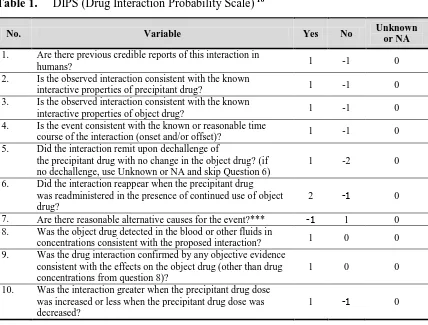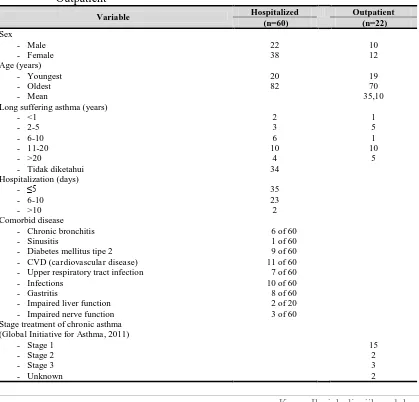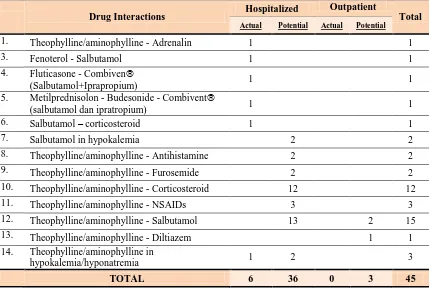Karya Ilmiah disajikan dalam: The 1st International Pharmacy Conference on Research and Practice November 2012, Yogyakarta DRUG INTERACTION ANALYSIS IN HOSPITALIZED AND OUTPATIENT
CARE OF ASTHMA PATIENT IN ADI HUSADA UNDAAN WETAN HOSPITAL, SURABAYA, INDONESIA
Amelia Lorensia1, Beny Canggih2, Rizka Indra Wijaya2 1
Lecturer, Pharmacy Faculty of Surabaya University, Surabaya, Indonesia 2
Pharmacist Student, Pharmacy Faculty of Surabaya University, Surabaya, Indonesia
Correspondence: amelia.lorensia@gmail.com
Surabaya University, Raya Kalirungkut Surabaya +628155020707
Asthma is a world wide chronic disease with an estimated 300 million affected individual. The medications for asthma therapy consist of several drugs, causing asthma patients susceptible to polypharmacy as a result of frequent use of multiple drugs simultaneously. This occur to appear a great concern of drug interactions as known to be related to adverse drug reactions and hospitalization, therefore a study to analyze the possibility of drug interactions in asthma patients is needed. This study consisted of two designs. There were retrospective design for hospitalized patient data for 2 years which all population were taken as a sample; and cross-sectional design for outpatient care data using purposive sampling methods to collect the sample for 3 months. Drug interactions were recorded and evaluated using DIPS (Drug Interaction Probability Scale) to determine the causation of interaction. Patients involved in this study were 60 hospitalized patients and 22 outpatients. The total numbers of drug interactions occured in this study were 6 actual cases and 39 potential cases. Those include 60% in hospitalized patients and 13.6% in outpatient. The outcomes from this observation showed that the interaction occurred mostly caused by asthma medication although it’s not harmful. Pharmacist’s role is needed in monitoring the medication to minimize and prevent adverse drug interactions. Polypharmacy and drug interaction represent potential health hazards for the patient.
Key words: drug interaction, asthma, hospitalized patient, outpatient, DIPS
Introduction
The National Asthma Education and Prevention Program (NAEPP) defines
asthma as a chronic inflammatory disorder of the airways in which many cells and
cellular elements play a role. In individuals with asthma, inflammation causes recurrent
episodes of wheezing, shortness, chest thightness, and cough.1 Actual asthma symptoms
can be treated and controlled, so that most patients can prevent the onset of symptoms
throughout the day, to prevent a serious attack.2 It’s currently estimate that there are
moret than 200 drugs known to affect the lungs adversely.3 It’s genereally
acknowledges that patients with known asthma or chronic obstructive pulmonary
disease are at the most significant risk tor drug-induced bronchospasm.4 Each patient
Karya Ilmiah disajikan dalam: The 1st International Pharmacy Conference on Research and Practice November 2012, Yogyakarta
level of asthma control. When asthma control has been achieved, ongoing monitoring is
essential to maintain control and to find the lowest step and the smallest dose of the
therapy, to minimize prices and maximize security terapi.1 Therefore therapy in asthma
is heterogeneous, depending on the clinical condition, function, and clinical outcomes.
So at the risk of asthma patients polipharmacy.5,6 Polypharmacy associated with an
increased risk of drug-related problems, especially drug interactions and clinical
outcomes merugikan.6,7 In a study conducted by Kirsten et al. (2007) in five hospitals in
Norway, showed that the number of potential risks for each patient DRPs linearly
related to the amount of drugs that are used while the patient is hospitalized, but are
limited when assessing DRPs on actual clinical conditions.8,9
The medications for asthma therapy consist of several drugs, causing asthma
patients susceptible to polypharmacy as a result of frequent use of multiple drugs
simultaneously. This occur to appear a great concern of drug interactions as known to
be related to adverse drug reactions and hospitalization, therefore a study to analyze the
possibility of drug interactions in asthma patients is needed.
Methodology
This study consisted of two designs. There were retrospective design for
hospitalized patient data for 2 years which all population were taken as a sample; and
cross-sectional design for outpatient care data using purposive sampling methods to
collect the sample for 3 months.
The study population was patients with asthma who are undergoing outpatient
treatment and meet the criteria for research, in hospitals (in clinical medicine) during the
study. Samples are asthma patients who are undergoing outpatient treatment and
fulfilled the criteria, can be found by investigators and were willing to be a sample of
research, in hospitals (in clinical medicine) during the study. Inclusion criteria for the
outpatient sample: (1) Patients asthma with aged 18 years and came to the polychlinic
in the hospital to undergo outpatient treatment during the study, (2) Patients who are
willing to participate in the research sample. Criteria exclusion (for the perception of
asthma):18 women pregnant/lactating, patients who have other respiratory diseases (such
as chronic obstructive pulmonary disease/COPD, emphysema, tuberculosis/TB),
Karya Ilmiah disajikan dalam: The 1st International Pharmacy Conference on Research and Practice November 2012, Yogyakarta
Drug interactions were recorded and evaluated using DIPS (Drug Interaction
Probability Scale) to determine the causation of interaction (Table 1). Directions:
- Circle the appropriate answer for each question, and add up the total score.
- Object drug = Drug affected by the interaction.
Precipitant drug = Drug that causes the interaction.
- Use the Unknown or Not Applicable (NA) category if (a) you do not have the
information or (b) the question is not applicable (eg, no dechallenge; dose not
changed, etc.).
Table 1. DIPS (Drug Interaction Probability Scale) 10
No. Variable Yes No Unknown
or NA
1. Are there previous credible reports of this interaction in
humans? 1 -1 0
2. Is the observed interaction consistent with the known
interactive properties of precipitant drug? 1 -1 0 3. Is the observed interaction consistent with the known
interactive properties of object drug? 1 -1 0
4. Is the event consistent with the known or reasonable time
course of the interaction (onset and/or offset)? 1 -1 0 5. Did the interaction remit upon dechallenge of
the precipitant drug with no change in the object drug? (if no dechallenge, use Unknown or NA and skip Question 6)
1 -2 0
6. Did the interaction reappear when the precipitant drug was readministered in the presence of continued use of object drug?
2 -1 0
7. Are there reasonable alternative causes for the event?*** -1 1 0 8. Was the object drug detected in the blood or other fluids in
concentrations consistent with the proposed interaction? 1 0 0 9. Was the drug interaction confirmed by any objective evidence
consistent with the effects on the object drug (other than drug concentrations from question 8)?
1 0 0
10. Was the interaction greater when the precipitant drug dose was increased or less when the precipitant drug dose was decreased?
1 -1 0
* A NO answer presumes that enough information was presented so that one would expect any alternative causes to be mentioned.
** When in doubt, use Unknown or NA designation.
*** Consider clinical conditions, other interacting drugs, lack of adherence, risk factors (eg, age, inappropriate doses of object drug).
Karya Ilmiah disajikan dalam: The 1st International Pharmacy Conference on Research and Practice November 2012, Yogyakarta Results and Discussions
Patients involved in this study were 60 hospitalized patients, consisting of 22
patients were male and 38 were female patients. And 22 outpatients, consisting of 10
men and 12 women.
Stage asthma in outpatients determined based interviewing according to the
Global Initiative for Asthma 2011. From the research looks variation experienced
asthma stage sample (Table 2). Most research samples are at stage 1 (68.18%).
Followed by 13.64% in stage 3; 9.09% at stage 2; 9.09% unknown, and 0% in stage 4
and 5. Two samples of the study were classified as stage of asthma is not known
because the medications used cannot be classified by the Global Initiative for Asthma
2011.
Table 2. Characteristics of The Study Sample Asthma Patients Asthma Inpatient and
Outpatient
Variable Hospitalized Outpatient (n=60) (n=22)
Sex - Male - Female 22 38 10 12 Age (years) - Youngest - Oldest - Mean 20 82 19 70 35,10 Long suffering asthma (years)
- <1 - 2-5 - 6-10 - 11-20 - >20
- Tidak diketahui
2 3 6 10 4 34 1 5 1 10 5 Hospitalization (days) - ≤5 - 6-10 - >10 35 23 2 Comorbid disease
- Chronic bronchitis - Sinusitis
- Diabetes mellitus tipe 2 - CVD (cardiovascular disease) - Upper respiratory tract infection - Infections
- Gastritis
- Impaired liver function - Impaired nerve function
6 of 60 1 of 60 9 of 60 11 of 60 7 of 60 10 of 60 8 of 60 2 of 20 3 of 60 Stage treatment of chronic asthma
(Global Initiative for Asthma, 2011) - Stage 1
- Stage 2 - Stage 3
- Unknown
Karya Ilmiah disajikan dalam: The 1st International Pharmacy Conference on Research and Practice November 2012, Yogyakarta
The total numbers of drug interactions occurred in this study were 6 actual cases
and 39 potential cases. Those include 60% of all drug-related problems (DRPs) in
hospitalized patients and in outpatients were 13.6% of all DRPs in outpatient (Table 3).
Table 3. Drug Interactions in Asthma Patients Inpatient and Outpatient
Drug Interactions Hospitalized
Outpatient
Total
Actual Potential Actual Potential
1. Theophylline/aminophylline - Adrenalin 1 1
3. Fenoterol - Salbutamol 1 1
4. Fluticasone - Combiven
(Salbutamol+Iprapropium) 1 1
5. Metilprednisolon - Budesonide - Combivent
(salbutamol dan ipratropium) 1 1
6. Salbutamol – corticosteroid 1 1
7. Salbutamol in hypokalemia 2 2
8. Theophylline/aminophylline - Antihistamine 2 2
9. Theophylline/aminophylline - Furosemide 2 2
10. Theophylline/aminophylline - Corticosteroid 12 12
11. Theophylline/aminophylline - NSAIDs 3 3
12. Theophylline/aminophylline - Salbutamol 13 2 15
13. Theophylline/aminophylline - Diltiazem 1 1
14. Theophylline/aminophylline in
hypokalemia/hyponatremia 1 2 3
TOTAL 6 36 0 3 45
Drug interaction between salbutamol and corticosteroids, causing an increase in
blood pressure (actual). B2 agonists (such as fenoterol, salbutamol, terbutaline) may
caused hypokalemia. It can be aggravated by corticosteroids is also a
potassium-depleting drugs. The risk of serious cardiac arrhythmias in patients with asthma may be
increased.11 B2 agonists alone can cause hypokalemia,11 so it can aggravate
hypokalemia.
Drug interaction between aminophylline/theophylline and antihistamines
(cetirizine) is potential, which showed no effect on the pharmacokinetics theophylline.11
Drug interaction between aminophylline/theophylline and Furosemide, is
Karya Ilmiah disajikan dalam: The 1st International Pharmacy Conference on Research and Practice November 2012, Yogyakarta
aminophylline/theophylline. Theophylline and diuretics, both of which can lead to
hypokalemia compounded.11
Drug interaction between aminophylline/theophylline and methylprednisolone, are
potential. The mechanism of interaction of the two is not clear. Theophylline and
corticosteroids have been shown to play a role over six asthma management. There is a
separate report, that there was an increase theophylline serum (associated with toxicity)
when oral or parenteral corticosteroids administered, but other reports indicate no
change. Both theophylline and corticosteroids can cause hypokalaemia which can be
exacerbated.11
Drug interaction between aminophylline/thephylline and NSAIDs, is potential.
NSAIDs may cause bronchoconstriction in asthmatic patients. Celecoxib rarely cause
bronchospasm in patients who are sensitive to aspirin or NSAIDs. NSAIDs do not affect
Theophylline levels in the blood.11
Drug interactions between Salbutamol (B2 Agonis) and Theophylline potentially
occur. The use of theophylline and beta agonists and are useful for treatment of asthma,
but the potentiation of the adverse effect may occur, the most serious condition is the
occurrence of hypokalemia and tachycardia, especially in the use of high doses of
theophylline, which that may occurs is the effect on heart rate or potassium levels. B2
agonists can cause hypokalemia, especially when given parenteral or nebulized.
Potassium-lowering effects of this drug interaction is unknown.11
Drug interaction between aminophylline/theophylline and salbutamol, is potential.
Use of co-operation between theophylline and B2 agonists in asthma management, but
some adverse effects may occur, the most serious effect is hypokalemia and tachycardia,
especially at high doses Theophylline. There was report of a study that some patients
had significantly decreased levels theofilin salbutamol when given intravenous.
Securities that may occurs is the effect on heart rate or potassium levels. B2 agonists
can cause hypokalemia, especially when given parenterally or nebulized.
Potassium-lowering effects of this drug interaction is unknown.11
Drug interactions between Diltiazem and Theophylline potentially occur. Giving
calcium channel blockers to patients taking theophylline normally not give adverse
effect on asthma control, even the smallest changes can occur in the serum levels of
Karya Ilmiah disajikan dalam: The 1st International Pharmacy Conference on Research and Practice November 2012, Yogyakarta
theophylline metabolism in the liver, which is likely to cyctochrome P450 isoenzyme
CYP1A2 inhibition.11
Drug interaction between aminophylline/theophylline as in hypokalemia and
hyponatremia (potential). Aminophylline/theophylline as in hypokalemia and
hyponatremia, will cause toxicity.11
Table 4. Evaluating Drug Interactions with DIPS Asthma Patients Inpatient and
Outpatient
Drug Interactions DIPS value
Theophylline/aminophylline - Adrenalin Possible drug interaction
Fenoterol - Salbutamol Possible drug interaction
Fluticasone - Combiven (Salbutamol+Iprapropium) Possible drug interaction
Metilprednisolon - Budesonide - Combivent (salbutamol dan ipratropium)
Possible drug interaction
Salbutamol – corticosteroid Possible drug interaction
Theophylline/aminophylline in hypokalemia/hyponatremia Possible drug interaction
The outcomes from this observation showed that the interaction occurred mostly caused by asthma medication although it’s not harmful. Pharmacist’s role is needed in monitoring the medication to minimize and prevent adverse drug interactions.
Polypharmacy and drug interaction represent potential health hazards for the patient.
Conclusion
There were 6 actual drug interaction event cases in hospitalized patient with the
DIPS value was possible drug interaction, and no drug interaction even were found in
outpatient asthma.
REFERENCE
1. Global Initiative for Asthma. Global Strategy for Asthma Management &
Prevention (Update); 2011.
2. Mangunrejo H, Widjaja A, Kusumo D, Sutoyo, Yunus F, Pradjnaporamita, et al.
Pedoman Diagnosis dan Penatalaksanaan di Indonesia: Asma. Perhimpunan Dokter
Karya Ilmiah disajikan dalam: The 1st International Pharmacy Conference on Research and Practice November 2012, Yogyakarta
3. Limper AH. Drug-Induced Lung Diseases: New Developments. 3rd ed. Highstown,
NJ: McGraw-Hill; 2000:1-11.
4. Cooper JAD Jr. Drug-induced lung disease. Adv Intern Med. 1997;42:231-268.
5. McDonald VM, Simpson JL, Higgins I, Gibson PD. Multidimensional assessment
of older people with asthma and COPD: clinical management and health status.
Age and Ageing 2011; 40(1):42-49.
6. Veehof LJ, Stewart RE, Meyboom-de Jong B, Haaijer-Ruskamp FM. The
development of polypharmacy: A longitudinal study. Family
Practice 2000; 17(3):261-267.
7. Koh Y, Kutty FBM, Li SC. Drug-related problems in hospitalized patients on
polypharmacy: the influence of age and gender. Therapeutics and Clinical Risk
Management 2005; 1(1): 39–48.
8. Bootman L. Drug Related Morbidity and Mortality Impact of Pharmaceutical Care,
World Health Organization: Essensial Medicines and Policy Department (EDM):
International Conferences on Improving Use of Medicines (ICIUM); 2007.
9. Kirsten K Viktil, Hege S Blix, Tron A Moger, Aasmund Reikvam. Polypharmacy
as commonly defined is an indicator of limited value in the assessment of
drug-related problems. Br J Clin Pharmacol 2007; 63(2): 187–195.
10. Horn JR, Hansten PD. How to assess drug interaction case reports. Pharm Times.
August 2006;72:32.
11. Baxter Karen, ed. Stockley’s Drug Interactions, 7th ed, Pharmaceutical Press,



